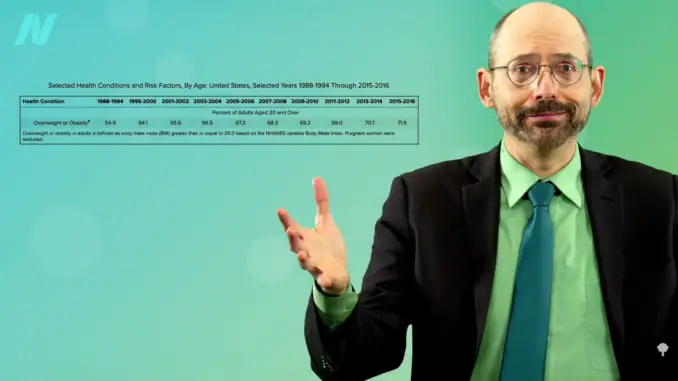
Rather than being some kind of disorder or a failure of willpower, weight gain is largely a normal response by normal people to an abnormal situation.
It’s been said that “Nothing in biology makes sense except in the light of evolution.” The known genetic contribution to obesity may be small, but, in a certain sense, you could argue that it’s all in our genes. The excess consumption of available calories may be hardwired into our DNA. We were born to eat.
Throughout human history and beyond, we existed in survival mode—in unpredictable scarcity. We’ve been programmed with a powerful drive to eat as much as we can while we can and just store the rest for later. Food availability could never be taken for granted, so those who ate more at the moment and were best able to store more fat for the future might better survive subsequent shortages to pass along their genes. So, generation after generation, millennia after millennia, those with lesser appetites may have died out, while those who gorged may have selectively lived long enough to pass along their genetic predisposition to eat and store more calories. That may be how we evolved into such voracious calorie-conserving machines. Now that we’re no longer living in such lean times, though, we’re no longer so lean ourselves.
What I just described is the “thrifty gene” concept proposed in 1962. As I discuss in my video The Thrifty Gene Theory: Survival of the Fattest, it suggests that obesity is the result of a “‘mismatch’ between the environment in which humans evolved and our modern environment”—like being a polar bear in a jungle. All that fur and fat may have given polar bears an edge in the Arctic but would be decidedly disadvantageous in the Congo. Similarly, a propensity to pack on the pounds may have been a plus in prehistoric times but can turn into a liability when our scarcity-sculpted biology is plopped down into the land of plenty. So, it’s not gluttony or sloth. Obesity may simply be “a normal response to an abnormal environment.”
Much of our physiology is finely tuned to stay within a narrow range of upper and lower limits. If we get too hot, we sweat; if we get too cold, we shiver. Our body has mechanisms to keep us in balance. In contrast, our bodies have had little reason to develop an upper limit to the accumulation of body fat. In the beginning, there may have been evolutionary pressures to keep lithe and nimble in the face of predation, but thanks to things like weapons and fire, we haven’t had to outrun as many saber-toothed tigers for about two million years or so. This may have left our genes with the one-sided selection pressures to binge on every morsel in sight and stockpile as many calories as possible in our bodies.
What was once adaptive is now a problem—or at least so says the thrifty gene hypothesis that originated more than half a century ago. It “provides a simple and elegant explanation for the modern obesity epidemic and was quickly embraced by scientists and lay people alike.” Although the researcher, James Neel, later distanced himself from the original proposal, the basic premise, despite remaining mostly theoretical, is still “largely accepted” by the scientific community, and the implications are profound.
In 2013, the American Medical Association voted to classify obesity as a disease (going against the advice of its own Council on Science and Public Health). Not that it necessarily matters what we call it, but disease implies dysfunction. Bariatric drugs and surgery are not correcting an anomaly in human physiology. Our bodies are just doing what they were designed to do in the face of excess calories. Rather than being some sort of disorder, weight gain is largely “a normal response by normal people to an abnormal environment.” As you can see below and at 4:12 in my video, more than 70 percent of Americans are now overweight. It’s normal.
“A body gaining weight when excess calories are available for consumption is behaving normally. Efforts to curtail such weight gain with drugs [or surgery] are not efforts to correct an anomaly in human physiology, but rather to deconstruct and reconstruct its normal operations at the core.”
If weight gain is largely a normal response by normal people to an abnormal situation, what exactly is that abnormal situation? Calorie-Rich-And-Processed Foods. (I’ll let you work out the acronym.) That’s the topic we’ll turn to next.
This is the third in an 11-video series on the history of the obesity epidemic. If you missed the first two, see The Role of Diet vs. Exercise in the Obesity Epidemic and The Role of Genes in the Obesity Epidemic.
There are eight more coming up. See the related posts below.
